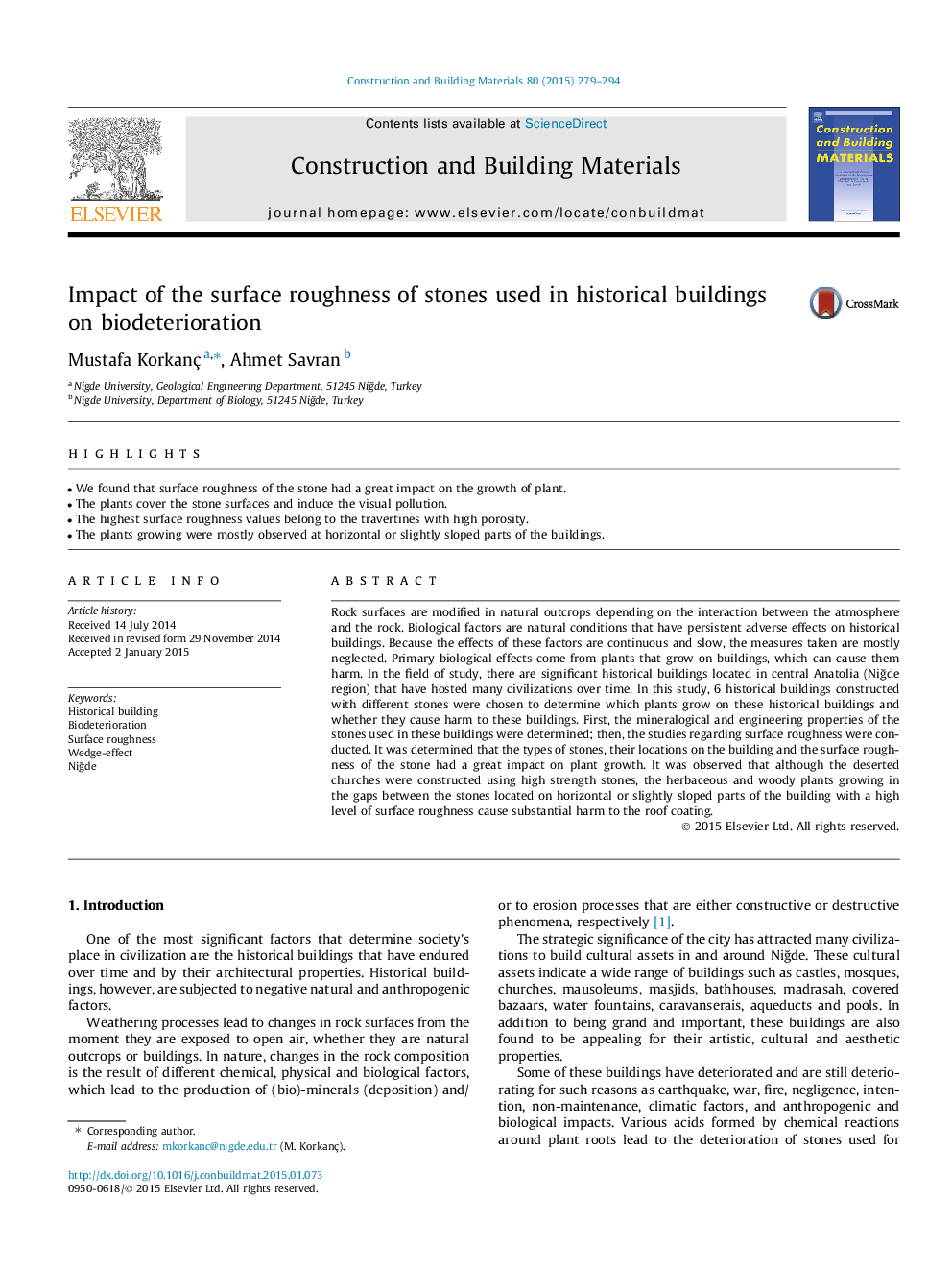| کد مقاله | کد نشریه | سال انتشار | مقاله انگلیسی | نسخه تمام متن |
|---|---|---|---|---|
| 6721342 | 503571 | 2015 | 16 صفحه PDF | دانلود رایگان |
عنوان انگلیسی مقاله ISI
Impact of the surface roughness of stones used in historical buildings on biodeterioration
ترجمه فارسی عنوان
تاثیر زبری سطح سنگ هایی که در ساختمان های تاریخی مورد استفاده قرار می گیرند، بر کاهش زیست محیطی
دانلود مقاله + سفارش ترجمه
دانلود مقاله ISI انگلیسی
رایگان برای ایرانیان
کلمات کلیدی
ساختمان تاریخی، کاهش وزن زبری سطح، اثر گوه، نایا د،
ترجمه چکیده
سطوح راک بسته به تعامل بین اتمسفر و سنگ در طبقاتی طبیعی اصلاح می شود. عوامل بیولوژیکی شرایط طبیعی هستند که تأثیرات نامطلوب بر ساختمان های تاریخی دارند. از آنجا که تأثیر این عوامل مستمر و آهسته است، اقدامات انجام شده اغلب نادیده گرفته می شود. اثرات بیولوژیکی اولیه از گیاهانی است که در ساختمان ها رشد می کنند و می توانند باعث آسیب شوند. در حوزه مطالعات، ساختمان های تاریخی قابل توجهی در آناتولی مرکزی وجود دارد که طی چندین دوره تمدن بسیاری را میزبانی کرده اند. در این مطالعه 6 ساختمان تاریخی با سنگ های مختلف ساخته شده اند تا مشخص شود که گیاهان در این ساختمان های تاریخی رشد می کنند و این که آیا آنها به این ساختمان ها آسیب می رسانند. اول، خواص کانی شناسی و مهندسی سنگ های مورد استفاده در این ساختمان ها تعیین شد؛ سپس مطالعات مربوط به زبری سطح انجام شد. مشخص شد که انواع سنگ ها، مکان های آنها بر روی ساختمان و زبری سطح سنگ تاثیر زیادی بر رشد گیاهان دارند. مشاهده شد که با وجود اینکه کلیساهای متروکه با استفاده از سنگهای سنگین مقاوم ساخته شده اند، گیاهان گیاهی و گیاهان در شکاف بین سنگ هایی که در قسمت های افقی یا کمی اندک از سطح ساختمان با سطح بالای زبری سطح رشد می کنند سبب آسیب جدی به سقف می شوند پوشش
موضوعات مرتبط
مهندسی و علوم پایه
سایر رشته های مهندسی
مهندسی عمران و سازه
چکیده انگلیسی
Rock surfaces are modified in natural outcrops depending on the interaction between the atmosphere and the rock. Biological factors are natural conditions that have persistent adverse effects on historical buildings. Because the effects of these factors are continuous and slow, the measures taken are mostly neglected. Primary biological effects come from plants that grow on buildings, which can cause them harm. In the field of study, there are significant historical buildings located in central Anatolia (NiÄde region) that have hosted many civilizations over time. In this study, 6 historical buildings constructed with different stones were chosen to determine which plants grow on these historical buildings and whether they cause harm to these buildings. First, the mineralogical and engineering properties of the stones used in these buildings were determined; then, the studies regarding surface roughness were conducted. It was determined that the types of stones, their locations on the building and the surface roughness of the stone had a great impact on plant growth. It was observed that although the deserted churches were constructed using high strength stones, the herbaceous and woody plants growing in the gaps between the stones located on horizontal or slightly sloped parts of the building with a high level of surface roughness cause substantial harm to the roof coating.
ناشر
Database: Elsevier - ScienceDirect (ساینس دایرکت)
Journal: Construction and Building Materials - Volume 80, 1 April 2015, Pages 279-294
Journal: Construction and Building Materials - Volume 80, 1 April 2015, Pages 279-294
نویسندگان
Mustafa Korkanç, Ahmet Savran,
